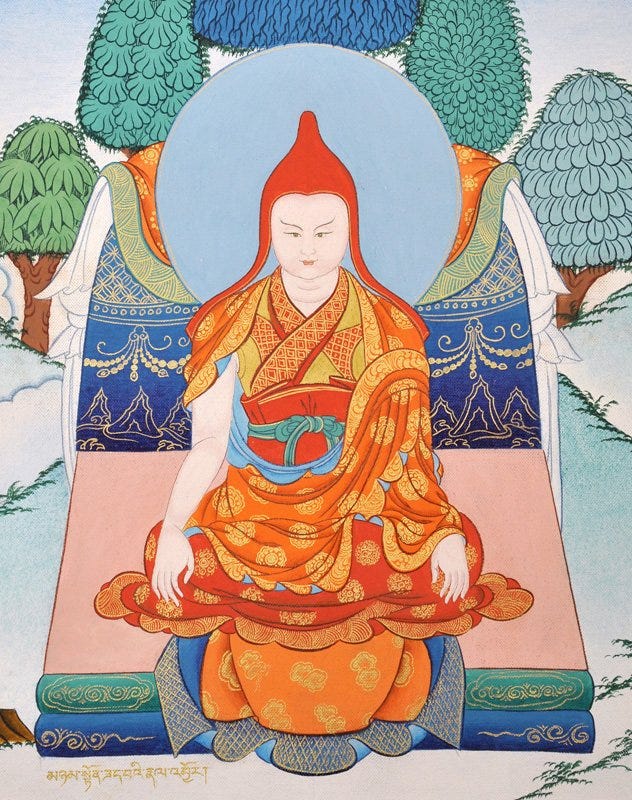How Amrtasiddhi's Mahamudra, Mahabandha and Mahavedha were practised in Tibet in the Shangpa Kagyu tradition
The story of how Virupa's Amrtasiddhi yoga reached the Tibetan Shangpa Kagyu tradition (translated from the hagiography of Sangye Nyenton12th-13th century)
Sangye Nyenton was unsuccessful in his practice because of his past bad karma. One day he decided that he would either die here or try to purify his past karmic obstacles so that he could attain enlightenment. So he went into retreat for three years and did sadhanas. One day he had a strong desire to look outside from his hut. When he looked out, he saw a yogi passing by. Sangye Nyenton asked the yogi, 'Where are you from? Who is your guru? What do you know? The yogi replied, 'I am from India, my guru is Dhurtroe Nagpopa (third lineage master of the Amrtasiddhi teachings)', and I know the Amrtasiddhi trulkhor'. So Sangye Nyenton learnt Amrtasiddhi trulkhor from him.

How the three principal yogic techniques of Amrtasiddhi were practised in Tibet, in the Shangpa tradition.
ཨཾ་གྲོལ་དགུ་ལ་བེ་ཏ་གསུམ་། །བྷན་དྷ་གཅིག་ཏུ་ཤེས་པར་བྱ། དེ་ལྟར་ཙེ་གཅིག་ཉམས་བླངས་པས། །རགས་པ་ཉོན་མོངས་རླུང་ཐུལ་ཏེ་། ལས་ཀྱི་རླུང་རྣམས་གསོད་པ་ཡིས་། ནད་གདོན་མི་ཚུགས་འཇོམས་པར་བྱེད་། ལུས་ཡང་མདངས་གསལ་ཟོ་མདོག་བདེ་། ཐིག་ལེ་འཕེལ་བས་ལུས་སྟོབས་རྒྱས་། ཕྲ་རླུང་རང་གནས་དག་པ་ཡིས་། ཡེས་ཤེས་རླུང་རྒྱས་ཟག་མེད་ཀྱི་། བདེ་བ་ཕྱོགས་མེད་རྒྱས་པར་འགྱུར་།
For nine mahamudra, do three mahavedha and one mahabandha. Through one-pointed practice in this way, the air of gross affliction (klesha) is subdued. By killing the karmic air, one becomes resistant to diseases and evil spirits and destroys them. The body becomes light, radiant and healthy in complexion. The growth of the bindu increases physical strength. By purifying the subtle air in its natural place, the vital air of primordial wisdom will grow. And untainted boundless bliss will flourish.
Amrtasiddhi 32 Trulkhor
This is taken from the Amrtasiddhi 32 trulkhor text composed by the 13th century Shangpa master Tsundue Singhe (aka Virya Simha student of Sangye Nyenton). In all Tibetan Amrtasiddhi texts written by Indians, the Sanskrit terms mahamudra, mahabandha and mahavedha are translated into Tibetan as phyag rgya chen mo, bsdam pa chen po and 'bigs pa chen po. It is only in the Amrtasiddhi trulkhor texts composed by Tibetan masters that the Sanskrit term mahabandha and mahavedha retain their Sanskrit term as bandha and Veta. However, in the Shangpa Kagyu Amrtasiddhi trulkhor texts, they have given a different name to the Hathayogic Mahamudra yoga technique as Am-grol, and Mahamudra has a different posture and technique. In this article I have used the Sanskrit terms mahamudra, mahabandha and mahavedha instead of Am-grol, bandha and veta for people who are more familiar with Hatha Yoga terms.
This article may be of interest to people who want to know how Amrtasiddhi's three main yoga techniques (Mahamudra, Mahavedha and Mahabandha) were practised in Tibet in the Shangpa Kagyu tradition. An anonymous annotation in the text says that the practitioner should perform Mahamudra, Mahavedha and Mahabandha thirteen times in succession (nine Mahamudra, three Mahavedha and one Mahabandha) to stop the movement of air through the right and left channels by directing the air into the central channel. One Mahavedha should be done for every three Mahamudra, and only one Mahabandha in total. That is, perform three Mahamudra followed by one Mahavedha in each of the three sets. And at the end of the complete sets, perform only one Mahabandha. Here is the description from the text of how to perform Mahamdura (Am-grol), Mahavedha (Veta) and Mahabandha (Bandha).
Mahamudra
On a comfortable seat, keep your spine straight. Block the anus with your left heel. Press it firmly against the root of your genital. This will close the channels of the two lower doors (anus and genital). With your right leg slightly stretched, hold your big toe with your right thumb, forefinger and middle finger and your left hand from the talus. In this position, expel the residual harmful air three times with force. Now inhale the air through right and left channels and insert the air into the central channel (below the navel). Now having your throat bent (throat locked), unite (samputa) the upper and lower air and draw the air upward with strong thrust to the limit of one’s breath.
Mahavedha
Bend over, leaving about five inches between your legs. Plant your shin and toes evenly and firmly on the ground. Bind the linga with your hand (this is done) by pressing the right thumb with the left hand (placed on the ground). The distance between the legs and the hands should be three spans. Then bend the head down, slowly lift the buttocks, throw the buttocks and thighs firmly onto the calves and the heels of the legs and shake them as long as one can.
Mahabandha
Keeping a distance of one cubit between the legs, wrap the arms around the legs from inside to outside and hold the two big toes with the thumb, forefinger and middle finger. After standing, bend the head downwards (directly towards the secret area), twist the body vigorously and stop. Reverse the anal (secret) chakra upwards, aligning the nadis (rtsa) and bindus (thig le) upwards.





Great article!